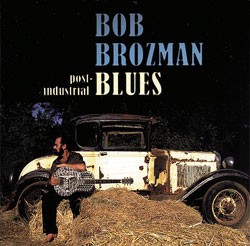
Photo courtesy Bob Brozman.
To many, the terms “musician,” “artist,” and “entertainer” are rarely applicable to one person en masse, but Bob Brozman fits the category. What’s more, the term “musicologist” would also be an appropriate designation – to say that the veteran player is a musical ambassador is an understatement, as he has traveled the world for years, purveying his unique music.
Brozman has recorded more than 30 solo albums or collaborations, many of the latter interesting efforts with musicians from other nations. His resume also includes authorship, as he wrote a definitive work titled The History & Artistry of National Resonator Instruments (Centerstream), published in 1993.
While Brozman is indeed best known for his work with resonator acoustic guitars, he is capable of displaying dazzling abilities on dozens of stringed instruments from around the globe. Lumiere, one of two albums Brozman released in 2007, was a multitracked, nearly-solo “Mike Oldfield uplugged”-type of effort that drips with diversity (instruments and musical stylings), and the cover shows Brozman’s “orchestra” (27 images of him brandishing 27 different instruments).
As for defining “world music” and his use of “world instruments,” Brozman recently told Vintage Guitar, “I think a distinction needs to be made between indigenous music, which is original music from cultures all around the world – I’ve been in over 60 countries – and world music, which is when we get mixing of cultures. And that included guys from Africa coming to America, picking up a guitar and starting something called blues – that’s a kind of world music that came about because of slavery, people being brought from one part of the world to another.
“What I think is most interesting about the musical history of the blues is that the 12-bar blues with three chords was not invented overnight. Africans coming from a modal culture were trying to figure out these crazy diatonic Western instruments, like the guitar. So for me, Delta blues is a kind of world music.”
Brozman described his interest in seeking out and learning to play other unique stringed instruments as “…pretty much a straight line. I was introduced to the resonator guitar as a child, and the possibilities of sound from a resonator are much more than with an electric guitar or a flat-top. Its dynamic range and tones set me on a path; my ears are always hungry for sound.”
Much of Brozman’s music has a foundation in rural Delta blues, a genre with which the resonator has been historically associated. His other 2007 album, Post-Industrial Blues, does lean towards Delta blues, but he managed to incorporate other “world instruments” onto that album as well, including two Hindustani slide guitars, a Bolivian charango, a Greek baglama (described by Brozman as a small bouzouki), a resonator ukulele, an 1860s Temletts seven-string banjo, and an Okinawan sanshin (a three-string fretless banjo), among others.
While Brozman uses vintage resonators in his recordings, he also uses modern-day resonator instruments, and has had a longtime working relationship with the National Reso-Phonic Guitar company of San Luis Obispo, California, since the early ’90s. The cover of Post-Industrial Blues shows him with a one-of-a-kind 1992 tri-cone prototype that has a circular brushed-metal pattern on its top.
“I’ve played old ones that were [unplayed], old ones that had been played a lot, and I’ve played lots of new ones,” he explained. “I started using new ones every day onstage in 2002, when I retired my last old one. The straight dope is that the new tricones sound as good out of the box as an old one, except for the first string. If you play it for six months, it sounds better than an old one – the bass is better, and from day one, the intonation is better, but I’ve played old ones in new condition, and they also took a few months to open up.”

Some might pigeonhole the songs on Post-Industrial Blues as protest songs or sociopolitical commentary, but Brozman begs to differ, particularly since as a world-traveling American musician he could be perceived as an ambassador, by default.
“I wanted to say something, without being preachy, that people in America would understand,” the guitarist clarified. “I’m not comin’ from left or right. Like ‘Look at New Orleans.’ I was being honest. I’ve got a young daughter, and I’m worried about what’s going to happen to this country 20 years down the road. That’s not a protest song; that’s a man wondering about his family. I think democracy is based on discourse; you should be able to exchange ideas. I’m saying this as a patriot who loves his country but asks questions about the people who are running it. I’ve traveled all over the world, and people desperately want to like us, but they’re having a hard time.”
Oddball-but-listenable instrument combinations abound on Post-Industrial Blues. For example, “Old Man Blues” pairs the seven-string banjo and the sanshin.
“It’s an obscure old thing with a giant skin head,” Brozman said of the Temletts seven-string. “It’s got six strings like a guitar, but a shorter extra string like a five-string banjo. It’s spooky; it has the most unhappy banjo sound you’ve ever heard! The sanshin is fretless, and the head is made of python skin. I just want weird sounds; I never use pedals or effects.”
Post-Industrial Blues also reunites Brozman with upright bassist Stan Poplin and drummer Jim Norris, with whom the guitarist had gigged in the ’80s.
“I love interacting with other musicians,” Brozman said. “And something like ‘Strange Ukulele Blues’ was something we weren’t even planning to do; it popped up in between takes. It was just a resonator ukulele, a banjo, and drums.”
Underscoring his role as a world traveler, Brozman headed to Australia last Christmas to do a brief tour. He’s worked with Aborigine musicians there, and is an adjunct professor at an Australian university. He was also planning early-’08 gigs with the Cheap Suit Serenaders and David Lindley.
Bob Brozman’s unique music, played on unique instruments, is always fascinating to anyone who hears it on his albums or in concert.
For more information, go to www.bobbrozman.com.
This article originally appeared in VG‘s April 2008 issue. All copyrights are by the author and Vintage Guitar magazine. Unauthorized replication or use is strictly prohibited.
Bob Brozman – Look At New Orleans



